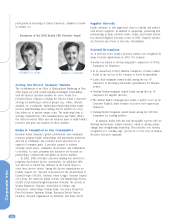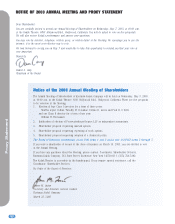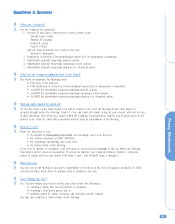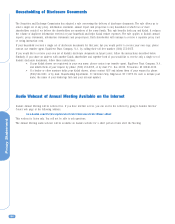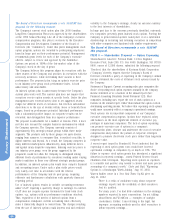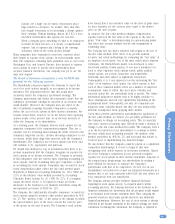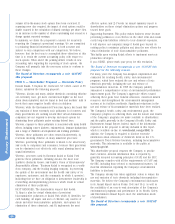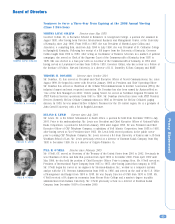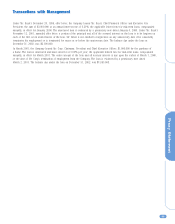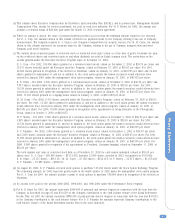Kodak 2002 Annual Report Download - page 92
Download and view the complete annual report
Please find page 92 of the 2002 Kodak annual report below. You can navigate through the pages in the report by either clicking on the pages listed below, or by using the keyword search tool below to find specific information within the annual report.
Proxy Statement
87
Options are a huge cost for many corporations and a
huge benefit to executives. No wonder, then, that they
have fought ferociously to avoid making a charge against
their earnings. Without blushing, almost all C.E.O.’s have
told their shareholders that options are cost-free…
When a company gives something of value to its employees
in return for their services, it is clearly a compensation
expense. And if expenses don’t belong in the earnings
statement, where in the world do they belong?
Many companies have responded to investors’ concerns about
their failure to expense stock options. In recent months, more
than 100 companies, including such prominent ones as Coca Cola,
Washington Post, and General Electric, have decided to expense
stock options in order to provide their shareholders more
accurate financial statements. Our company has yet to act. We
urge your support.”
The Board of Directors recommends a vote AGAINST this
proposal for the following reasons:
The Shareholder proposal requests the Company to report the
cost of its stock options annually as an expense in its income
statement. The proponent believes that this would more
accurately reflect the Company’s operational earnings. The
Company understands and shares the proponent’s desire that the
Company’s operational earnings be reported in an accurate and
sound manner. Moreover, the Company does not object to the
idea of uniformly requiring all public companies to properly
reflect the cost of stock options in their income statements. For
reasons stated below, however, we do not believe that expensing
options would, at the present time, be in the best interests of
either the Company or its shareholders.
As a starting point, the Company believes stock options are an
important component of its compensation program. They are a
valuable tool for recruiting and retaining the talent critical to the
Company’s long-term success. Options encourage employees to act
as owners, which helps align their interests with the Company’s
shareholders. The Company’s use of stock options has been, and
will continue to be, appropriate and judicious.
We should also mention by way of introduction that there is no
present requirement that the Company recognize an expense for
stock options in its income statement. The Company is presently
in full compliance with the current rules regarding accounting for
stock options. Current accounting rules give companies a choice
in accounting for stock options. Companies may account for stock-
based compensation under either the fair value method under
Statement of Financial Accounting Standards No. 123 (“SFAS No.
123”) or the intrinsic value method provided by Accounting
Principles Board Opinion No. 25 (“APB No. 25”). If a company
adopts the latter choice, it is required to make pro forma
disclosure in the footnotes to its financial statements using the
measurement provisions of SFAS No. 123.
The Company, like substantially all public companies, accounts for
stock options using the intrinsic value method prescribed by APB
No. 25. The “intrinsic value” of the option is the amount by which
the quoted market price of the stock exceeds the exercise price
of the option on the date of grant. The Company’s stock options
have always had a zero intrinsic value on the date of grant since
we have routinely set the exercise price equal to the market
price on the date of grant.
In contrast, the fair value method computes compensation
expense based on the fair value of the options at the date of
grant. “Fair value” is determined using an option-pricing model
that takes into account multiple factors and assumptions in
estimating value.
The Company has two major concerns with regard to the use of
the fair value method. First, there is no present uniform,
accurate and tested methodology for computing the “fair value” of
an employee stock option. One of the most widely used valuation
techniques, the Black-Scholes model, was developed to value
short-term publicly traded options. It was never intended to be
used to value employee stock options which, unlike publicly
traded options, are private, long-term, non-transferable,
forfeitable and often subject to significant restrictions.
Consequently, it is a very imprecise tool for measuring the “fair
value” of an employee stock option. Our other concern is that
each of these valuation models relies on a number of subjective
assumptions, some of which, like stock price volatility and
expected option life, are particularly hard to predict. The values
determined using these models tend to be highly sensitive to
these assumptions and can vary significantly depending on the
assumptions made. Consequently, not only are companies not
using the same valuation model, but they are also using wildly
different assumptions when applying these models.
Given these present uncertainties surrounding the application of
the fair value method, we believe it is presently premature for
the Company to change its accounting policy. This is especially
true since current accounting rules effectively make a decision to
change to the fair value method irrevocable. The Company feels it
is in the best interest of our shareholders to continue to follow
the most widely used accounting standard, the intrinsic value
method prescribed by APB No. 25, and wait until this debate is
resolved prior to implementing any material change.
We also believe that the Company could be placed at a significant
competitive disadvantage if it were to begin at this time
recognizing stock option expense in its income statement. Almost
all of the Company’s competitors do not presently recognize
expense for stock options in their income statements. Adoption of
the proposal may disadvantage our shareholders by making it
more difficult for investors to compare the Company’s
performance with that of its competitors. We feel it is in our
shareholders’ best interest to report our financial statements in a
manner that is not only consistent with GAAP, but also allows for
easy comparison with our competitors.
The Company already provides extensive financial disclosure
regarding its stock option activity. As required under current
accounting practices, the Company discloses in the footnotes to its
financial statements the information that the proposal would require
to be included in the income statement itself. Thus, adopting the
proposal would not necessarily provide investors any additional
financial information. Moreover, the cost of stock options is already
reflected in the income statement in the diluted earnings per share
calculation. In making this calculation, the Company is required to


